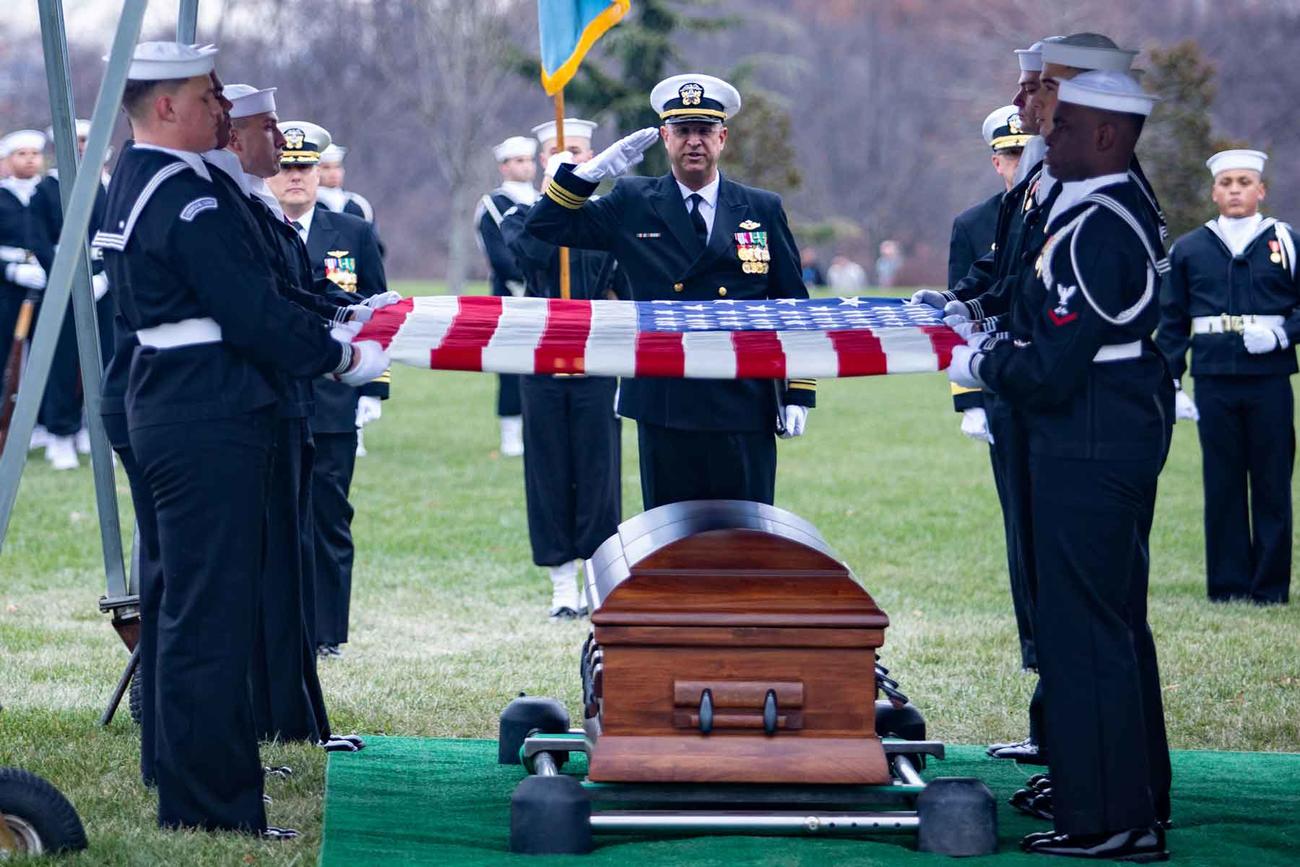
As the bugle fell silent on the fields of Arlington National Cemetery on a gray December Thursday, a heroic sailor was finally laid to rest 82 years after his story and that of one of the most defining moments of American history became intertwined.
The sailor was Seaman 1st Class James Ward. He was stationed aboard the battleship USS Oklahoma when the Japanese struck Pearl Harbor on Dec. 7, 1941.
As the ship, holed by three aerial torpedoes, began to roll and sink in the bay, Ward remained at his 14″ gun turret holding a flashlight — an act of heroism that meant the rest of the turret crew could see their way to safety but at the cost of his own life. His actions earned him the Medal of Honor.
Read Next: Army Wraps $95 Million Project Renovating Moldy Fort Liberty Barracks, Demolishing Others
Ward, who enlisted in the Navy just about a year prior to Pearl Harbor, became one of five Oklahoma sailors who would be honored for heroism and courage for their actions on that day and one of 16 Medal of Honor recipients related to the attack. He also became one of 429 sailors — about one-third of the crew — who would perish on the USS Oklahoma.
After the Oklahoma was righted in 1944 after spending three years on its side, Ward was among the 388 sailors and Marines whose remains could not be identified. Unsuccessful attempts to identify any of the remains in 1947 led to the Oklahoma service members being buried at the National Memorial Cemetery of the Pacific as unknowns until a 2015 Defense Department effort saw them exhumed for the final time.
Richard Hannah, 67, who is Ward’s nephew and closest living relative, told Military.com on Thursday that “the process from [2015] forward has been arduous, fascinating, and just remarkable that they can do that.”
In 2021, the Defense POW/MIA Accounting Agency (DPAA) was able to positively identify Ward’s remains using modern dental and anthropological analysis, as well as DNA testing.
Hannah said that his grandparents didn’t talk about the sailor much but “the Navy had a very nice portrait done of him, and they had that up in the house.”
“I think they would have been very proud,” Hannah said, before adding that he chalks up the lack of family conversation to a kind of humility that he’s been told is not uncommon for that generation. “I think if you would ask most of those folks from that time period, and even today, they don’t see themselves as heroes.”
Among the honors that Ward was given since his actions at Pearl Harbor was becoming the namesake of a destroyer escort in 1943. In 2015, the Springfield City School District also named Ward an Alumni of Distinction.
When it came time to make the arrangements for the funeral, the Navy’s mortuary affairs office took great pains to ensure Ward’s remains would be buried with the honors he deserved.
Petty Officer Lawson Reynolds told Military.com in an interview that he and the rest of the staff from that office made sure there was a uniform to bury Ward in and “we worked the process to get the Medal of Honor.”
Reynolds was moved by Ward’s heroism and selfless actions, and he volunteered to be the escort for the remains.
“I had the Medal of Honor that I had carried from Millington, Tennessee, to the contracted funeral home in Omaha, Nebraska, who got the remains from DPAA,” Reynolds explained, before adding that he was the one who had the honor of laying the Medal of Honor in the casket. “It was very emotional, being able to put that on and know that it will always be with him, he is finally being laid to rest with what he deserves for his service to this country and his fellow service members.”
A Navy press release said that Adm. Lisa Franchetti, the Navy’s top officer, presented Ward’s family with a replacement Medal of Honor medal at the ceremony, as well as a Medal of Honor Flag and a copy of Ward’s citation ahead of the funeral.
From there, Reynolds escorted the casket to Washington, D.C., and volunteered to stay for the funeral “to show my respect for the service member and to just see the process from beginning to end.”
At Arlington, Ward was accorded full military honors. His casket carried up a hill deep inside the cemetery accompanied by the Old Guard and Navy Band. Before the ceremony, four F/A-18 Super Hornets performed a flyover in a missing man formation — an aerial salute where one plane peels off from the group to signify a lost service member — over Ward’s grave site.
Among the attendees were Franchetti herself; Vice Adm. Johnny Wolfe Jr., the officer who would present the flag to the Ward family; as well as the Navy’s top enlisted official, Master Chief Petty Officer of the Navy James Honea; and two Medal of Honor recipients.
After the ceremony, Hannah said that he was also moved by the attention the Navy had given his uncle — especially Franchetti’s attendance.
“Having the first female admiral, the top ranking command officer in the United States Navy, part of the Joint Chiefs of Staff, the first woman in history, being there was incredibly … that was very touching,” he said.
After identification of Ward, there were 33 sets of unknown remains left from the original 388, with the DPAA concluding that it doesn’t currently have the technology to identify them.
On Dec. 7, 2021, on the 80th anniversary of the attack on Pearl Harbor, those final 33 sailors were reinterred at the National Memorial Cemetery of the Pacific. Since then, however, one more sailor has been identified.
Related: Pearl Harbor, Day of Infamy









